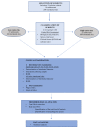The Oral Bacterial Microbiome of Interdental Surfaces in Adolescents According to Carious Risk
- PMID: 31491909
- PMCID: PMC6780098
- DOI: 10.3390/microorganisms7090319
The Oral Bacterial Microbiome of Interdental Surfaces in Adolescents According to Carious Risk
Abstract
Adolescence is closely associated with a high risk of caries. The identification of specific bacteria in an oral microniche, the interdental space of the molars, according to carious risk can facilitate the prediction of future caries and the anticipation of the progression or stabilization of caries in adolescents. A cross-sectional clinical study according to the bacteriological criteria of interdental healthy adolescents and carious risk factors-low and high-using a real-time polymerase chain reaction technique was conducted. The presence of 26 oral pathogens from the interdental microbiota of 50 adolescents aged 15 to 17 years were qualitatively and quantitatively analyzed. Bacteria known to be cariogenic (Bifidobacterium dentium, Lactobacillus spp., Rothia dentocariosa, Streptococcus cristatus, Streptococcus mutans, Streptococcus salivarius, Streptococcus sobrinus, and Streptococcus wiggsiae) did not present differences in abundance according to carious risk. Periodontal bacteria from the red complex are positively correlated with carious risk. However, only 3 bacteria-S. sobrinus, E corrodens and T. forsythia-presented a significant increase in the highest group. Estimating the risk of caries associated with bacterial factors in interdental sites of molars in adolescents contributes to the better definition of carious risk status, periodicity and intensity of diagnostic, prevention and restorative services.
Keywords: adolescents; carious risk; interdental microbiota; oral microbiome.
Conflict of interest statement
The authors declare no conflict of interest.
Figures




Similar articles
-
Quantification of carious pathogens in the interdental microbiota of young caries-free adults.PLoS One. 2017 Oct 10;12(10):e0185804. doi: 10.1371/journal.pone.0185804. eCollection 2017. PLoS One. 2017. PMID: 29016613 Free PMC article.
-
Microbiota of interdental space of adolescents according to Risk of Caries: A cross-sectional study protocol.Contemp Clin Trials Commun. 2019 Oct 18;16:100444. doi: 10.1016/j.conctc.2019.100444. eCollection 2019 Dec. Contemp Clin Trials Commun. 2019. PMID: 31709310 Free PMC article.
-
Quantitative assessment of salivary oral bacteria according to the severity of dental caries in childhood.Arch Oral Biol. 2017 Nov;83:282-288. doi: 10.1016/j.archoralbio.2017.08.006. Epub 2017 Aug 16. Arch Oral Biol. 2017. PMID: 28858630
-
Anti-caries Streptococcus spp.: A potential preventive tool for special needs patients.Spec Care Dentist. 2024 May-Jun;44(3):813-822. doi: 10.1111/scd.12920. Epub 2023 Sep 6. Spec Care Dentist. 2024. PMID: 37674277 Review.
-
The Caries Microbiome: Implications for Reversing Dysbiosis.Adv Dent Res. 2018 Feb;29(1):78-85. doi: 10.1177/0022034517736496. Adv Dent Res. 2018. PMID: 29355414 Review.
Cited by
-
Caries Increment and Salivary Microbiome during University Life: A Prospective Cohort Study.Int J Environ Res Public Health. 2020 May 25;17(10):3713. doi: 10.3390/ijerph17103713. Int J Environ Res Public Health. 2020. PMID: 32466124 Free PMC article.
-
Antibacterial effect of a disinfectant spray for sports mouthguards on Streptococcus sobrinus.Dent Res J (Isfahan). 2021 Jul 19;18:59. eCollection 2021. Dent Res J (Isfahan). 2021. PMID: 34497694 Free PMC article.
-
Clinical Study and Microbiological Analysis of Periodontopathogenic Microflora Analyzed among Children and Adolescents with Cardiovascular Diseases Compared to Group with Good General Status.Pediatr Rep. 2024 Jun 18;16(2):482-503. doi: 10.3390/pediatric16020041. Pediatr Rep. 2024. PMID: 38921706 Free PMC article.
-
Supragingival microbial profiles in caries-free and caries-active adolescents treated with fixed orthodontics.Curr Res Microb Sci. 2025 Aug 8;9:100455. doi: 10.1016/j.crmicr.2025.100455. eCollection 2025. Curr Res Microb Sci. 2025. PMID: 40837523 Free PMC article.
-
Periodontal Pathogens and Their Links to Neuroinflammation and Neurodegeneration.Microorganisms. 2023 Jul 18;11(7):1832. doi: 10.3390/microorganisms11071832. Microorganisms. 2023. PMID: 37513004 Free PMC article. Review.
References
-
- Global Burden of Disease Study 2017 (GBD 2017) Data Resources|GHDx. [(accessed on 14 December 2018)]; Available online: http://ghdx.healthdata.org/gbd-2017.
LinkOut - more resources
Full Text Sources
Molecular Biology Databases
Miscellaneous

